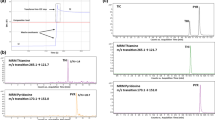The primary, bioactive component of Cordyceps militaris, known as cordycepin (3'-deoxyadenosine), has been utilized extensively as a traditional medicinal ingredient and a nutritious diet in Asian nations. To determine the amount of cordycepin in the C. militaris, high-performance liquid chromatography (HPLC) is shown to be an effective, sensitive, and straightforward analytical technique. Other methods for estimating cordycepin include near infrared spectroscopy and capillary electrophoresis–mass spectrometry. The UV-Vis spectroscopy approach was used to quantify cordycepin, and the results were statistically confirmed and compared with an HPLC method. For linearity, repeatability, precision, reproducibility, limit of detection and limit of quantification, the method was verified. The established approach can be utilized for routine, quality control analysis of cordycepin, as it is easy to use, sensitive, accurate, precise, repeatable, and most importantly, cost-effective.
Similar content being viewed by others
References
B. M. Twaij and M. N. Hasan, Int. J. Plant Biol., 13, 4 (2022).
M. K. Patel, S. Pandey, M. Kumar, M. I. Haque, S. Pal, and N. S. Yadav, Plants, 10, 1 (2021).
L. Wang, H. Yan, B. Zeng, and Z. Hu, Bioengineering, 9, 1 (2022).
H. S. Cunningham, K. G. Manson, and W. Spring, Nature, 949 (1950).
A. M. Sugar and R. P. M. C. Caffrey, Antimicrob. Agents Chemother., 42, 1424 (1998).
H. S. Tuli, S. S. Sandhu, K. Dharambir, and A. K. Sharma, World J. Pharm. Pharm. Sci., 3, 1525 (2014).
K. Nakamura, K. Shinozuka, and N. Yoshikawa, J. Pharmacol. Sci., 127, 53 (2015).
H. J. Cho, J. Y. Cho, M. H. Rhee, C. R. Lim, and H. J. Park, J. Pharm. Pharmacol., 58, 1677 (2006).
X. Ying, L. Peng, H. Chen, Y. Shen, K. Yu, and S. Cheng, Int. Orthop., 38, 1519 (2014).
S. Shin, S. Lee, J. Kwon, S. Moon, S. Lee, C.-K. Lee, K. Cho, N.-J. Ha, and K. Kim, Immune Netw., 9, 98 (2009).
P. Guo, Q. Kai, J. Gao, Z. qin Lian, C. ming Wu, C. ai Wu, and H. bo Zhu, J. Pharmacol. Sci., 113, 395 (2010).
Z. Zhang, K. Li, Z. Zheng, and Y. Liu, BMC Pharmacol. Toxicol., 23, 1 (2022).
J. Wang, H. Chen, W. Li, and L. Shan, J. Biochem. Mol. Toxicol., 35, 1 (2021).
H. B. Li, J. K. Chen, Z. X. Su, Q. L. Jin, L. W. Deng, G. Huang, and J. N. Shen, Cancer Cell Int., 21, 1 (2021).
A. Panya, P. Songprakhon, S. Panwong, K. Jantakee, T. Kaewkod, Y. Tragoolpua, N. Sawasdee, V. Sanghiran Lee, P. Nimmanpipug, and P. T. Yenchitsomanus, Molecules, 26 (2021).
T. H. Hsu, L. H. Shiao, C. Hsieh, and D. M. Chang, Food Chem., 78, 463 (2002).
J.-H. Xiao and Y. Q. Q. Xiong, Recent Pat. Biotechnol., 7, 153 (2015).
Y.-M. L. Hankun Hu, Ling Xiao, Baogen Zheng, and Xin Wei, Anal. Bioanal. Chem., 407, 139 (2016).
B.-Q. J. Jiang-Feng Song, and Chun-Quan Liu, J. Chem. Technol. Biotechnol., 83, 1163 (2008).
H. Fan, S. P. Li, J. J. Xiang, C. M. Lai, F. Q. Yang, J. L. Gao, and Y. T. Wang, Anal. Chim. Acta, 567, 218 (2006).
Y. S. Rie Ikeda, Miho Nishimura, and M. W. K. Nakashima, Biomed. Chromatogr., 22, 630 (2008).
L. Y. Wang, X. Liang, J. Zhao, Y. Wang, and S. P. Li, J. AOAC Int., 102, Article ID 741 (2019).
N. Singpoonga, R. Rittiron, B. Seang-On, P. Chaiprasart, and Y. Bantadjan, ACS Omega, 5, 27235 (2020).
F. Q. Yang, L. Ge, J. W. H. Yong, S. N. Tan, and S. P. Li, J. Pharm. Biomed. Anal., 50, 307 (2009).
P. Alam, F. Shakeel, M. H. Alqarni, A. I. Foudah, T. M. Aljarba, A. Alam, M. M. Ghoneim, S. M. B. Asdaq, S. Alshehri, and M. Iqbal, Separations, 10 (2023).
W. Li, Z. Qian, Y. Zou, G. Tan, W. Li, Q. Lei, R. Li, and D. Lan, Acta Chromatogr., 1 (2022).
Author information
Authors and Affiliations
Corresponding author
Additional information
Abstract of article is published in Zhurnal Prikladnoi Spektroskopii, Vol. 91, No. 1, p. 169, January–February, 2024.
Rights and permissions
Springer Nature or its licensor (e.g. a society or other partner) holds exclusive rights to this article under a publishing agreement with the author(s) or other rightsholder(s); author self-archiving of the accepted manuscript version of this article is solely governed by the terms of such publishing agreement and applicable law.
About this article
Cite this article
Krishna, K.V., Devasia, J. & Malaviya, A. Development and Validation of the UV-Spectrophotometric Method for the Determination of Cordycepin, a Nucleoside. J Appl Spectrosc 91, 228–235 (2024). https://doi.org/10.1007/s10812-024-01710-2
Published:
Issue Date:
DOI: https://doi.org/10.1007/s10812-024-01710-2




